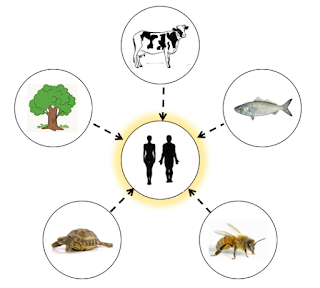Semantic transposition as a central device for semogenesis in language
By Rodrigo Cáceres Riquelme
The purpose of this essay is to define, develop and test the concept of semantic transposition, in order to see what this concept can show us about the logic of semogenetics (in Halliday's sense), this is, the logic that governs the origin of the meaning of concepts and conceptual systems. The way I apply the concept of semantic transposition should be understood as an attempt to improve the prevailing concept of 'metaphor' in the sense used by Lakoff and Johnson (2003), a metaphor being 'understanding one thing in terms of another'. My main problem with the concept of metaphor is that its meaning in common language is too far from the meaning it takes in cognitive linguistics.
In common language we understand metaphors as linguistic devices that help us convey a meaningful message to another person in a concrete, vivid way. Metaphors exploit a perceived similarity between the things that one associates. For example, if I say 'I love you with the vigour of the wind' we understand this as a metaphor because we do not take the sentence literally, and because the image of the wind blowing with strength is a vivid image that is assumed to be compared to the way somebody loves. In sum, we understand the sentence 'the vigour of the wind' as mapped or transposed onto an imagined 'way of loving' that is implicitly present.
Here we should ask: why do we spontaneously understand 'the vigour of the wind' as a 'way of loving' ? This happens because in these kinds of contexts we understand the accompaniment term 'with' to be referring to the manner in which an Actor carries out an action. This is evident in other examples as when we say things like 'he said so with a bit of anger in his words' 'she died with deep equanimity'. In these kinds of contexts, what follows the word 'with' is understood as mode, way or manner of performing the action that precedes the term 'with'.
In this manner, we can say that the meaningful image of a vigorous wind was transposed onto the 'way of loving' that is implicitly understood by the presence of the accompaniment term 'with'.
Another example of semantic transposition is what happens in the language of political ideologies. Political ideologies are conventionally understood through the schematic structure of a horizontal line -which in Lakoff & Johnson's terms corresponds to an image schema. It is an image because lines are things that we see, and it is a schema because a line has a schematic regular structure: it has a center, sides, left, right, extremes, points and distances between points. If it does not have these aspects, then it is not a horizontal line.
So what is it that occurs in politics? We see that this horizontal line structure is transposed, mapped onto the way people talk about their political ideas: there is the Left, the Right (or left-wing and right-wing, depending on the country), there is extreme left, extreme right, center and people are placed somewhere along this line according to their political ideas.
So what is it that occurs in politics? We see that this horizontal line structure is transposed, mapped onto the way people talk about their political ideas: there is the Left, the Right (or left-wing and right-wing, depending on the country), there is extreme left, extreme right, center and people are placed somewhere along this line according to their political ideas.
Would we say that this is a metaphor? If we understand metaphor as we do in common language, then the answer is no, because metaphors are things that people do not take literally, and in this case people do take very seriously this horizontal line schema in order to talk about their right and left political ideas, as well as to frame their competitions between Left and Right to get elected.
Just to make manifest the complete arbitrariness of the use of this horizontal line, let's say that in a parallel universe people did not adopt a horizontal line, but instead a vertical line in order to talk about politics. Vertical lines are different because their structure has a center, height, up/top, bottom/down, extremes, points and distance between points. In this parallel universe people would have up-level and down-level political ideas and elections would go around the battle between the Up and the Down.
What we can infer from all this is that the current, prevailing conceptual structure of politics depends on the availability of the horizontal line schema. In other words, this image-schema needs to previously exist in order to be transposed onto politics and be then a practical way to speak about different political ideas and locate them in an imagined horizontal line.
Semantic transposition is thus a general phenomenon where concepts and conceptual systems (like the political conceptual system) gain meaning and structure from a transposition of aspects of experience (e.g. linear schemas, container schemas, part-whole schemas) that may or may not be inherently related to the meaning of a specific concept. As we saw, the transposition of a horizontal line onto politics is totally arbitrary, because there is no inherent relationship or similarity between them that justifies this transposition. Other forms might as well have been transposed onto politics, such as a vertical line, a sphere, a triangle, etc.
To come back to Lakoff & Johnson's deconstruction of western philosophy (1999), a reinterpretation of their main conclusions would amount to say that virtually all philosophical reflection that humans have undertaken necessarily relies on semantic transpositions in order for them to be meaningful. "The fact that abstract thought is mostly metaphorical means that answers to philosophical questions have always been, and always will be, mostly metaphorical" (p.7).
This necessarily has tremendous consequences for philosophy because it means that for more than two millenia, philosophy has been blind to its reliance on semantic transpositions of aspects of experience onto abstract concepts. As Lakoff & Johnson argue, philosophy has operated on the belief that there is a discontinuity between lived, embodied experience and conceptual structures. In other words, it has relied on the belief that concepts and reason have a transcendent structure that is fully independent of our embodied lived experience. In turn, this means that classical philosophical problems can actually be consequences of the very form of experiential schemas that are mapped onto abstract concepts.
Probably the greatest example of this is philosophy's theory of mind. As we can infer from common language about the mind when we say things like 'thoughts came into my mind', 'I can’t get you out of my head', 'it’s all in your mind' and so on, the structure of a container is mapped or transposed onto the concept of mind. As we understand from experience, a container is a a bounded, isolated, independent object with an inside/outside orientation, an internal/external separation and an input/output dynamic. A container can have contents, it can be empty and things can be put in and out of it. We consequently note that in common language we employ the container concepts of 'in', 'out', 'inside', 'outside' and 'into' in order to talk about the concept of 'mind'.
Descartes’ dualism is an example of someone that took literally this container schema when he spoke of the “internal mind” or res cogitans that forms perceptions and ideas from the “external material world” or res extensa. The point is that this dualism internal/external literally requires the availability of the container schema that is subsequently transposed onto the concept of mind. When transposed onto the mind, the container schema entails a strict separation from what is 'inside the mind' and what is 'outside the mind'. In turn, this inside/outside separation is transposed onto the classic western dualities of subject/object and subjective/objective, the subject supposedly being us, the ones that inhabit the “internal mind” and the objects being the “external material reality” that is believed to be independent from us. I have written elsewhere on the details of this container-like understanding of the mind (link here).
Out of this transposed container-schematic structure arise the classical epistemological problems in philosophy of (i) how can we 'get outside' our perspective in order to gain objective knowledge and (ii) how do 'external material objects' become 'internal subjective perceptions and ideas'. In other words, the idea that one might 'get outside' one's perspective makes only sense in reference to the transposed container schema. There is nothing 'objective' or 'solid' about Descartes' dualism because its meaningfulness relies on the transposition of an aspect of experience: our constant interaction with the manifold containers we find while coping with the world: houses, rooms, cars, boxes and our own bodies.
To sum up, I have tried to make the case that the concept of semantic transposition is more general than the usually accepted concept of metaphor and conceptual metaphor. The first argument was simply the idea that our common understanding of metaphor differs significantly with its meaning in conceptual metaphor theory, which may difficult its understanding throughout academia and the public. The second, most relevant argument, is that the concept of metaphor is commonly used to denote sentences, as in 'that's a lovely metaphor'. Conversely, the concept of semantic transposition is not denoting a sentence but it is rather denoting a relationship of transposition between two meaningful signs, starting from one that is usually issued from lived embodied experience, to be mapped onto an abstract concept like 'mind', 'time' or 'politics'.
The concept of semantic transposition also sheds light onto the fact that abstract concepts and philosophies become meaningful precisely because they employ aspects of lived experience such as linear schemas and container schemas as the 'raw materials' to create new meanings and invent novel things and practices like nation-states, parliaments, police, jails, schools and universities.
___________________________________________________________________________
Consider supporting us so we can keep bringing you more high quality and deeply insightful content.
Consider supporting us so we can keep bringing you more high quality and deeply insightful content.
References
Halliday, M. A. K., & Matthiessen, C. (2006). Construing experience through meaning: A language-based approach to cognition. A&C Black.
Lakoff, G., & Johnson, M. (1999). Philosophy in the flesh: The embodied mind and its challenge to western thought (Vol. 28). New York: Basic books.
Lakoff, G., & Johnson, M. (2003). Metaphors we live by. 1980. Chicago: U of Chicago P.





Thanks for sharing this
ReplyDelete